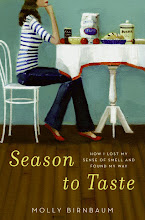Monday, September 24, 2012
Wednesday, September 19, 2012
Grilled Pork and Peaches
That’s right. Pork butt. And
peaches. On the grill. In less than an hour. If summer has to end, we might as
well send it off in style.
In Cambridge, I live in a
studio apartment. There’s no fire escape or roof access. There certainly isn’t
a grill. But at my family’s place Maine? There are multiple rooms in the house.
There’s even a yard. And a deck. And a grill. A big fat gas grill. The
possibilities are endless.
For this dish, a perfect
late-summer dish (though I know I’m now pushing this dangerously close to
fall), I used a recipe from the New York
Times. It accompanied an article called “How To Burn Dinner,” written by
Sam Sifton, who really has this uncanny ability to turn a hunk of tough, fatty
meat into something quiet poetic.
As the title implies, it’s
an article about burning your dinner. Or, not quite burning your dinner. “What
you are looking for on the edges of the meat and fruit is color: a deep, dark
brown that is almost black — a black without bitter, a burn that is not burned,”
Sifton writes.
It’s all about a technique
championed by Francis Mallmann in his cookbook (written with Peter Kaminsky) “Seven Fires: Grilling the Argentinean Way”– cooking a piece of meat outdoors over
high heat, on a chapa, or a leggy
cast-iron construction, to create a thick, crunchy crust. “If Mallmann’s
cooking were music, it would be very loud,” writes Sifton.
It was easy. I took a
2-pound piece of pork butt. Butterflied it. Trimmed it. Pounded it down. I liberally
seasoned the meat with salt and pepper. I slathered it with a mixture of olive
oil, rosemary, and garlic. I heated up the grill with two cast iron pans on the
grates.
When they got hot, super
hot, smoking hot, I plunked the pork right on down and didn’t move it for 15
minutes. Oh, man: that crust! I then flipped the pork and let it cook for a
good 15 minutes more. The high heat of the grill causes something called the
Maillard reaction, a chemical reaction between denatured proteins and sugars, which
begins to take place at just about 300 degrees. This is what causes the
familiar deep brown color on searing meats (and, for that matter, toasted bread
and caramel) and a build up of flavor molecules—in this case, that pungent
porcine deliciousness of a thick, bronzed crust.
After the pork came off the
grill to rest, I stuck halved peaches, cut-side down, into the hot cast iron
pans. They cooked quickly in the pork fat (and a little bit of butter, too).
They were a sweet, silky counterpoint to the crunchy, lusciously fatty meat.
I served the pork and
peaches alongside a simple green salad. Bread. Red wine. Oysters, too. (Why not? Welcome
to Maine.) (Goodbye to summer.)
Grilled Pork and Peaches on a Gas Grill
Adapted from the New York Times, Sam Sifton, and Francis
Mallmann
2 pounds boneless pork butt,
butterflied and trimmed
10 garlic cloves, peeled and
minced
2 tablespoons fresh
rosemary, chopped
8 tablespoons olive oil
salt and pepper
6 peaches, halved and pitted
(skin on)
4 tablespoons unsalted
butter
Turn on your grill. Set it
to high. Place a very large cast iron pan (or two smaller ones) over the
burners. Let it get hot. Very hot.
While the grill heats, work
on the pork. Place the butterflied pork on a cutting board and pound it with a
meat mallet until it’s evenly thick—about ¾ inch across.
Mix together the garlic,
rosemary, and 6 tablespoons of the oil in a small bowl. Season the pork
(liberally, “aggressively,” says Sifton) with salt and pepper on both sides.
Spread the garlic mixture on both sides as well. Because I used two smaller
cast iron pans on the grill, I cut my pork in half, so that I could cook each
piece simultaneously.
Back to the grill. Turn the
heat to medium. Brush the pan (or pans) with the remaining oil. Let the oil
heat up for a minute, and then place the meat in the pan(s) and leave it alone.
Don’t touch it. This is what will get it that crust, that char, that flavor. I
let my pork sit for 15 minutes. Sifton says 10. It depends on how hot your
grill is, how thick your pans and pork are. It’s important to do what feels
right here. Wait until that crust forms.
Use tongs to turn over the
meat (or pieces of meat). Cook for another good 10 – 15 minutes. When the meat
is nice and crusty, remove it, place it on a cutting board, tent it with foil,
and let it rest.
Now, take the halved peaches
and place them, cut side down, in the cast iron pan(s). Dot them with butter.
Cook for about five minutes, until soft and slightly charred.
Slice the meat and serve with
the peaches. And salad. And bread. And wine. (And oysters.)
Subscribe to:
Posts (Atom)



















